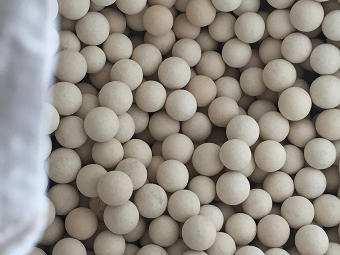Production process of the alumina ball
Mar 30, 2022
The alumina ball is made of industrial alumina and refractory kaolin through scientific formula, forming and high temperature calcination, and the maximum heat resistance temperature can reach 1900 degrees.
Classification of alumina balls
Alumina balls are divided into clay alumina balls and high-alumina bricks. Clay alumina balls are suitable for converters and shift furnaces in the sulfuric acid and fertilizer industries. It is suitable for high and low temperature shift furnaces, reformers, hydroconverters, desulfurization tanks and methanation furnaces in chemical fertilizer plants, and plays the role of dispersing gas and liquid, and supporting, covering and protecting catalysts.
The main feature of the clay ball is its low softening point under load. This is because a lot of liquid phase occurs in the clay ball at a lower temperature, so its application temperature is low. The types of high alumina balls with low Al2O3 content are similar to clay balls, but with the addition of Al2O3 content, the phase is added accordingly, and the glass phase is reduced, so other functions are improved. However, the thermal shock resistance of high spherical aluminum is basically similar to that of clay balls, except for the types with high content.
The alumina ball looks small, but its production process is the same as the production process of the refractory brick. Whether it is from the preparation before production or the production process, there can be no carelessness.

The following describes the production process of the alumina ball
1. According to the requirements of the alumina ball target required by the acquisition department of the technical department, the raw materials for the production of alumina balls will be inspected on-site and the samples will be tested. The purchased raw materials are subjected to strict inspection and selection, processed into 0-3 grain size and 180 mesh powder, and then passed through a 16000 high-magnetism iron remover for iron removal, and then enters the silo for use.
2. The mold workshop manufactures molds according to the mold manufacturing drawings and scaling ratios issued by the technical department. The manufactured semi-finished products must be checked for dimensions, and heat treatment can be performed only after they are correct.
3. According to the production process issued by the company's technical department, the molding workshop conducts random inspection on the particle size and fine powder fineness of the raw materials with a sample sieve. After passing the qualification, the electronic batching truck will carry out the proportioning of light bricks, and then enter the mixing mill for mixing and grinding. 10 - 15 minutes for the pot to be trapped, and 2-4 hours to start molding. When molding, according to the scale issued by the company's technical department, the number of single hammers and the body density of semi-finished products are checked, and mass production can be carried out only after the confirmation is correct. The products are supervised by semi-finished quality inspectors. The semi-finished products produced must reach the same unit weight, the blocks are over the ruler, the surface is smooth, there is no burrs, and there are no brown eyes before they can enter the next process to be installed in the kiln.
4. In the firing workshop, the semi-finished alumina balls entering the kiln should be inspected for the size burrs and brown eyes. After the inspection is correct, the kiln can be installed. The semi-finished alumina balls of the kiln are strictly controlled, and it is required that no unqualified semi-finished products enter the furnace.
5. The high quality high alumina refractory balls of the products after leaving the kiln are checked and selected by the company's inspection workshop for the size and appearance of the products. The alumina balls that meet the user's requirements are regarded as genuine products. A batch of 100 tons of alumina balls out of the kiln will be self-inspected and sent to the company's laboratory for testing. The statement is checked with the user's physical and chemical goals, and the product is ready for shipment after any errors.
6.The shipping department packs the inspected products according to the user's packaging and transportation requirements. The alumina ball indicates the raw material, color number, receiving unit, production unit, telephone, and a self-inspection test statement during delivery. Professionals enter the construction site to hand over the goods. Therefore, as a supplier, we must always pay attention to the sales situation of our customers and make accurate predictions.

Relevant information
-

Main properties of magnesium oxide refractory
Performance characteristics of magnesia refractories and other basic refractories Performance characteristics of magnesia refractories and other basic refractories Refractories containing more than 80% ... -

What properties of lightweight insulation fire clay bricks can be improved by the addition of kyanite?
Lightweight insulation fire clay bricks are a kind of shaped refractory material with clay as the main raw material, which is processed, shaped, dried, and calcined with clay. on the kiln. Due to the r ... -

How is the effect of white fused alumina abrasive used in refractory materials?
After mixing, forming, drying, and firing at high temperature in a shuttle kiln. The product has the characteristics of high refractoriness, good thermal shock stability of white corundum, high high te ... -

Characteristics of refractory magnesia chrome bricks for lime kiln
Lime kilns are mainly classified into square kilns and circular kilns. According to the classification of fired products, they can be divided into lime kilns, ceramic kilns, cement kilns, glass kilns, ...

